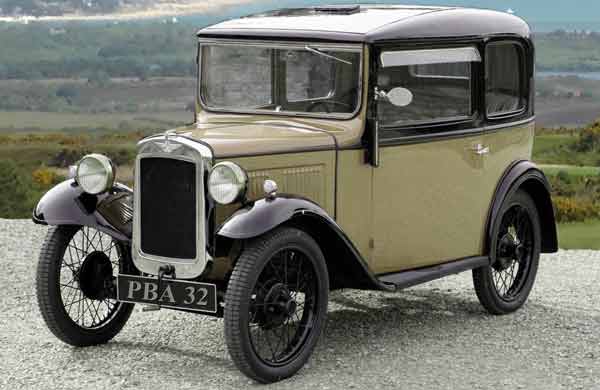Get Quotes For Cheap UK Car Insurance!

The Austin Seven
By 1920 The Austin Motor Company was in trouble. It had been founded in 1905 by Herbert Austin, who left his employer Wolseley in order to start his own business. Until the First World War his company grew steadily, building mainly large cars, and then during the war large defence contracts for military trucks and ambulances came along and the workforce grew to exceed 22,000 people. The end of the war, however, put an end to these contracts but worse was to follow; in 1920, in an effort to conserve scarce resources, the British government put huge taxes on large cars. Turnover fell dramatically, money ran out quickly and the company went into administration.
Drastic measures were necessary. Herbert Austin decided that the company should manufacture a small car for the mass market to compete with the cheap and lightweight 'cycle cars' and motorcycle combinations that were proving so popular. What he envisaged however was a proper car, which would sell at a price that would make it competitive with these flimsy machines.
The other Austin Motor Company directors, and many of the company's creditors, were appalled. Since the company was in receivership it was not going to be possible to borrow money for this project and so Herbert Austin decided to do most of the funding himself. Together with a talented young draughtsman, Stanley Edge from the company's Longbridge factory, he squirrelled himself away using the billiards room at his home as a design studio.
Together they designed the Austin Seven and by 1922 three prototypes had been built at Longbridge. Many of the patents for the new innovations were Mr Austin's own property.
The car was small. No, let's make that tiny. Altogether it was just nine feet long, with a wheelbase (that is, the distance between the centres of the front and back wheels) of just six foot three inches, or 1.9 metres. This made it not only smaller than the Ford model T but about half it's weight as well. This not only meant that a smaller engine would be adequate to power it, but the size of the engine meant much lower purchase tax as well.
The Austin Seven offered seating for four people. There were brakes on all four wheels, and it's 700 cc engine was capable of 40 mph.
At the launch price of £165, which fell steadily as production mounted, the car sold well with nearly 2500 sales in it's first year. The market for 'cycle cars' was virtually wiped out by this upstart.
Building cars for sale wasn't the only way of making money however. A great deal was earned from licensing other manufacturers to produce their own versions of it. These were manufactured worldwide including in France and the USA, and even the now mighty BMW began by building Austin Sevens under licence.
Allegedly the Japanese company Datsun produced a close copy of the car; no license fees were ever paid however.
By the time WW2 started, and production had to come to an end, about 290,000 had been built. Such was the strength and lightness of the design that after World War II many Austin Sevens were converted into racing cars, including the first one created by Bruce McLaren and the first ever Lotus. William Lyons of the Swallow Sidecar Company used them as the base of his SS range; after the Second World War the 'SS' name had bad connotations and so it was changed to Jaguar, a company which is still building cars long after The Austin Motor Company has become just a memory.